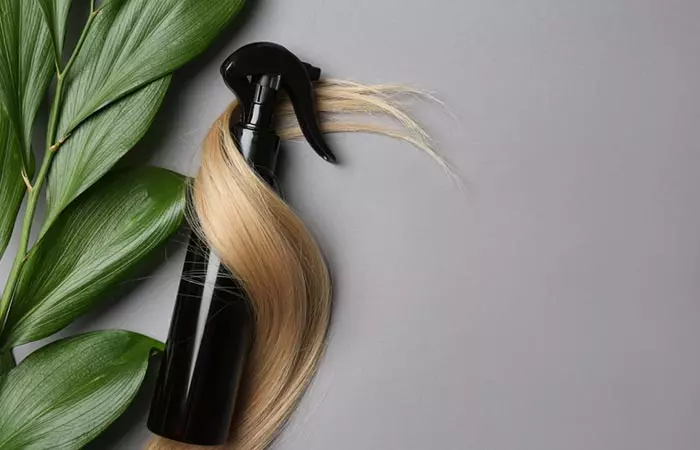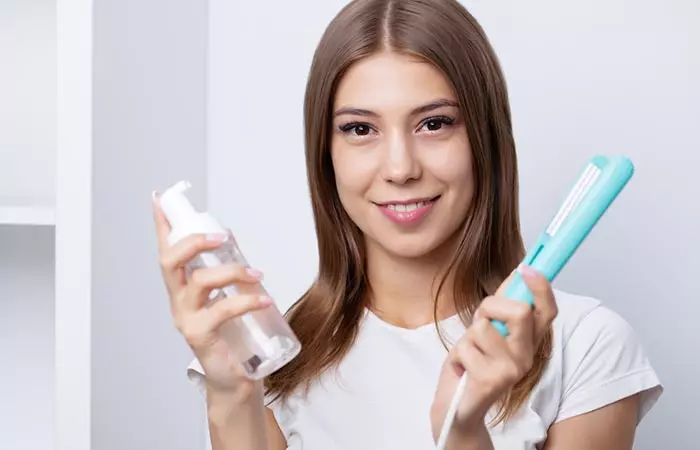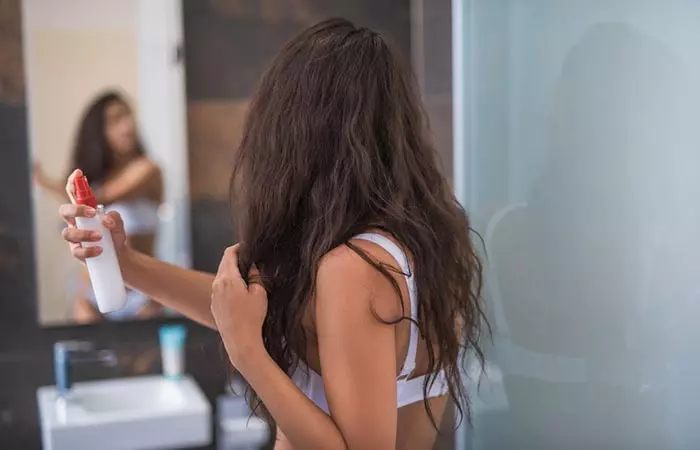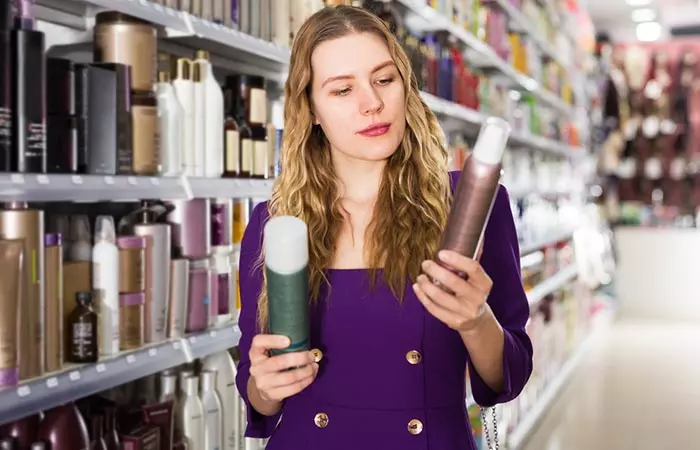In this article, we look into the benefits of heat protectants, how to use them to get maximum benefits, and all other related information. Keep scrolling to know more. Heat protectants are leave-in products used before styling your hair. They are available in cream, spray, or oil formulas. They can condition your hair, tame frizz, and boost hair shine. Heat protectants can benefit your hair in more ways than one. We have briefly discussed them below.
Benefits Of Heat Protectants
Heat protectants smoothen the cuticles of your hair shaft. They make your hair less porous and less prone to frizz in humid weather (1). They restore hair moisture. Using one before styling can keep your hair conditioned (2). They prevent moisture loss from factors like dehydration, high heat, or a dry environment. They work by adding a protective layer to your hair shaft. They aid hair loss prevention by lubricating your hair and making it more manageable. Your hair will be easy to detangle.
Caroline Amecha, a natural hair and lifestyle blogger, shares her bad experience of heat styling at a Kenyan local salon, “Should I even get started on heat application? Everything was wrong about it. There was no application of heat protectant which is meant to provide a barrier from the heat and reduce chances of heat damage (i).” She reports it as the very first reason that led to the damage to her natural curls. Now you know why using a heat protectant is a no-brainer. Its benefits extend beyond protecting your hair from the heat. But here is the thing – using a heat protectant the right way will give you the best results. We have discussed the same below.
How To Use It?
Apply a heat protectant to damp hair before you style. Damp/conditioned hair promotes better absorption of the product. Begin styling once your hair is dry. Use the right tools with ceramic or tourmaline plates that minimize hair damage. If you have dry hair, apply the heat protectant while your hair is wet and top it off with a good conditioning serum before you start styling. Never style your hair while it is wet. Hair is brittle when wet and can break when styled. Note: You can use heat protectants every time you style your hair. However, minimize using styling tools to reduce hair damage. Robbie Anne, a fitness and health blogger, writes about how she didn’t take heat protectants seriously at first because of all the ion technology and leave-in conditioning talks around the town. However, she realized her mistakes after her hair started showing signs of damage. “I needed to begin using a daily heat protectant product that could fend off the frizz and lock in the moisture keeping my hair healthy feeling and looking (ii),” she says about how she made changes in her hair care routine to incorporate heat protection. Heat protectants salvage your hair from the harsh styling tools. However, not all are made alike. The best heat protectants have certain parameters in place. You must look for the same before making a purchase.
What Should You Look For In A Heat Protectant?
Following is the list of ingredients you can check for in your heat protectant. Silicones: Heat protectants are generally made with a combination of two silicones – Cyclomethicone and dimethicone. While Cyclomethicone moisturizes your hair, dimethicone coats it and prevents moisture loss (3). Dimethicone forms a layer on your hair and makes your cuticles lie flat. This keeps your hair from turning frizzy. You can find this ingredient in your everyday conditioner too. However, those with oily hair must go for a product with minimum silicone (as it can build-up in hair and make hair greasier). Hydrolyzed Wheat Protein: Hydrolyzed wheat protein conditions hair (4). It also takes the place of the natural hair proteins in the hair, which otherwise can get broken due to heat. PVP/DMAPA Acrylates Copolymer: This copolymer, like silicones, helps protect hair and detangles it. Some research shows this copolymer may protect hair from thermal damage (5). Quaternary 70: This is found in high-end products that may protect hair from heat damage (5). It keeps hair frizz-free after heat styling. It also keeps your hair smooth until the next wash. Can I use a heat protectant every day? Using heat protectant every time you heat-style your hair will prevent hair damage. However, styling your hair with heat daily can make your hair dry, brittle, and prone to breakage. So, it is best to avoid heat styling every day. In addition, it will limit your usage of heat protectant, which ultimately contains chemicals. Is heat protectant spray or cream better? Both heat protectant spray and cream have their pros and cons. While the spray is easy to use, applying the cream can be a hassle. However, heat protectant cream is known to provide better protection than the spray. What should you avoid in a heat protectant? Heat protectants should be devoid of high alcohol content, synthetic fragrances, and phthalates as they may dry out the hair and cause damage. It should also be free from mineral oil as it may make hair greasy. Do you put heat protectant before or after the leave-in conditioner? It is recommended to apply a heat protectant before a leave-in conditioner as it ensures adequate heat protection before styling the hair. After 15 minutes, the conditioner can be applied to impart a shiny look to the hair. What are some common myths about heat protectants, and how can they be debunked? There are a few common myths associated with heat protectants. They can be debunked easily with a little research and an understanding of one’s hair type. However, we have covered a few common heat-protectant myths. Myth: There is no need to apply heat protectant for every hair styling Truth: Heat protectants should be applied every time while styling the hair with straighteners or blow dryers. Myth: Heat styling hair can be done regularly if a heat protectant is used. Truth: Although heat protectants protect hair from heat damage, heat styling of the hair shouldn’t be done regularly as it may negatively affect hair growth and texture. Myth: All heat protectants are the same Truth: Every heat protectant has a unique formulation and can vary greatly depending on the hair type










